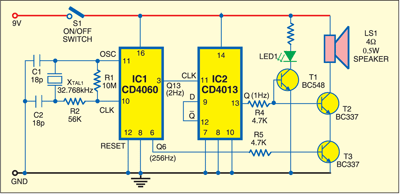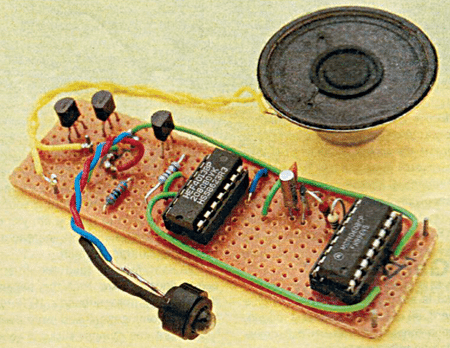 This timer makes an LED flash once every second along with a beep. The timing circuit uses a quartz crystal available in digital watches or clocks which generates precise frequency of 32.768 kHz.
This timer makes an LED flash once every second along with a beep. The timing circuit uses a quartz crystal available in digital watches or clocks which generates precise frequency of 32.768 kHz.
The circuit comprises a 14-stage ripple-carry binary counter and oscillator IC CD4060 (IC1), dual flip-flop CD4013 (IC2), transistors T1, T2 and T3, a speaker, a quartz crystal and a few discrete components. The inbuilt inverter of IC1 (which is between pins 10 and 11) in combination with resistors, capacitors and the quartz crystal forms the oscillator circuit.
The clock signal of 32.768 kHz has a pulse width of about 30 microseconds, which is far too short to be able to count the oscillations. So this frequency is fed to IC1, which divides it by 14 to output a frequency of 2 Hz

The 2Hz output is fed to IC2, which divides it by 2, giving a final output of 1 Hz or one pulse per second at its pin 13. The 1Hz pulse is fed to transistors T1 and T2. Transistor T3 is driven by a 256Hz audible tone from output Q6 of IC1. Transistors T2 and T3 are connected in series. As clock pulses are applied to the base of transistor T2, it conducts once every second. Transistor T3 conducts to produce a tone from the speaker. LED1 also flashes for every clock pulse received.

Assemble the circuit on a general-purpose PCB and enclose in a cabinet. Mount the miniature speaker, LED1 and power switch S1 on the front panel of the cabinet. Switch S1 can be single-pole, single-throw type or a push-switch with push-on/push-off action. The circuit is powered by a 9V PP3 battery. It can also operate off a 6V or 12V battery.
This 1Hz clock timer can be used in counters, stop watches and other digital circuits.










The clock frequency is NOT divided by 14 instead of 2^14=8192